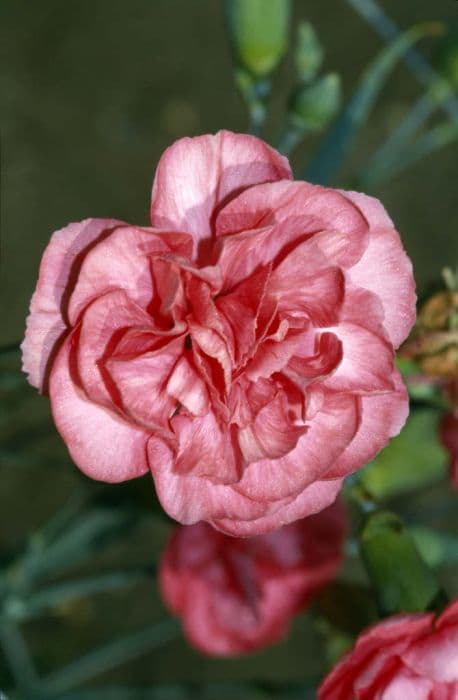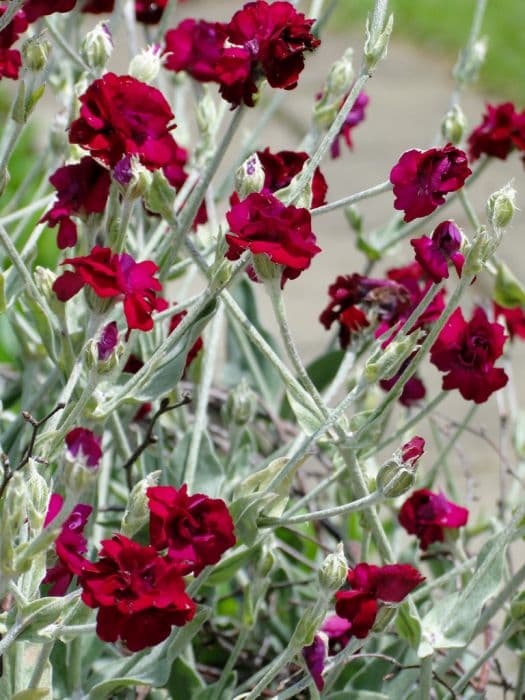Baby's breath 'Rosenschleier' Gypsophila 'Rosenschleier' (d)

ABOUT
'Rosenschleier' is a compact semi-evergreen perennial to 30cm in height, making a low mound of slender stems with narrow, grey-green leaves and large, open panicles of pale pink double flowers 1cm in width
About this plant
 Names
NamesFamily
Caryophyllaceae
Synonyms
Baby's Breath, Gypsophila, Rosenschleier
Common names
Gypsophila paniculata 'Rosenschleier'.
 Characteristics
CharacteristicsLife cycle
Perennials
Foliage type
Deciduous
Color of leaves
Green
Flower color
Pink
Height
2-3 feet (60-90 cm)
Spread
2-3 feet (60-90 cm)
Plant type
Herb
Hardiness zones
3
Native area
Eurasia
Benefits
 General Benefits
General Benefits- Decorative Appeal: Adds delicate texture to gardens and bouquets with its fine, lacy flowers.
- Attracts Pollinators: Brings beneficial bees, butterflies, and other pollinating insects to the garden.
- Drought Tolerance: Once established, it can withstand dry periods, reducing the need for frequent watering.
- Easy to Grow: This plant is relatively low-maintenance, making it suitable for novice gardeners.
- Soil Adaptability: Tolerates a wide range of soil conditions, although it prefers well-drained soil.
- Long Blooming Season: Provides flowers for an extended period, usually throughout the summer.
- Landscape Filler: Quickly grows to fill in spaces, perfect for borders or as a ground cover.
- Companion Planting: Works well with other plants in mixed beds, complementing roses and other perennials.
- Cut Flower: The stems are commonly used in floral arrangements and last well when cut.
- Event Decor: Popular for weddings and special events due to its ethereal and romantic appearance.
 Medical Properties
Medical PropertiesThis plant is not used for medical purposes.
 Air-purifying Qualities
Air-purifying QualitiesThis plant is not specifically known for air purifying qualities.
 Other Uses
Other Uses- Floral dye: Gypsophila flowers can be used to create a natural dye for textiles, offering a range of soft, pastel colors when used in the dyeing process.
- Photography props: These delicate flowers are often used as props in professional photography, adding texture and a romantic touch to photoshoots.
- Homemade potpourri: Dried Gypsophila flowers are a beautiful addition to homemade potpourri mixes, adding volume and a gentle, pleasant scent.
- Bookmarks and paperweights: Pressed Gypsophila flowers can be used to craft unique bookmarks or to be encapsulated in resin to create decorative paperweights.
- Culinary decoration: Although not commonly consumed, Gypsophila can be used as an edible decoration for cakes and desserts, provided they are pesticide-free.
- Gift wrapping: Tiny sprigs of Gypsophila can be used to embellish gift wrap or to create natural and rustic-looking bows and other decorations.
- Artistic inspiration: The intricate structure of Gypsophila has inspired many artists and can be found depicted in paintings, drawings, and textile designs.
- Plant dye for crafts: The blooms can also be used to create a soft-hued plant dye for coloring wool, silk, or even Easter eggs.
- Biodegradable confetti: Dried Gypsophila petals make excellent biodegradable confetti for eco-friendly celebrations such as weddings or parties.
- Scented sachets: Gypsophila can be added to scented sachets to subtly fragrance linens and clothing when placed in drawers or closets.
Interesting Facts
 Feng Shui
Feng ShuiThe plant commonly known as Baby's Breath is not used in Feng Shui practice.
 Zodiac Sign Compitability
Zodiac Sign CompitabilityThe plant Baby's Breath is not used in astrology practice.
 Plant Symbolism
Plant Symbolism- Purity: Gypsophila, commonly known as Baby's Breath, often symbolizes purity and innocence because of its delicate and dainty white blooms.
- Love: It is frequently used in weddings and romantic occasions, which lends it a symbolic association with everlasting love and affection.
- Compassion: The light and airy appearance of Baby's Breath can represent compassion and a gentle touch in the language of flowers.
- Fertility: In some cultures, Baby's Breath is associated with fertility due to its abundant, clustered blossoms and rapid growth.
- Freedom: Because it can thrive in a variety of conditions, Baby's Breath sometimes symbolizes freedom and adaptability.
 Water
WaterBaby's Breath should be watered deeply but infrequently, ensuring the soil dries out slightly between watering. A general rule is to water approximately once a week, providing about 1 gallon of water for each plant. During hot and dry spells, you may need to water more frequently, especially if the plant is in well-draining soil that doesn't retain moisture. It's crucial to avoid overwatering, as this can lead to root rot. Always check the top inch of the soil for dryness before adding water.
 Light
LightBaby's Breath thrives in full sunlight, meaning it should receive at least 6 hours of direct sunlight daily. The best spot for this plant is an open area where it can bask in unobstructed daylight. If grown indoors, place it near a south-facing window for optimal light exposure.
 Temperature
TemperatureBaby's Breath prefers moderate temperatures and can tolerate a range from about 40°F to 80°F. The ideal temperature for this plant's growth and blooming is between 60°F and 70°F. It can survive light frosts but should be protected from extreme cold or heat.
 Pruning
PruningPrune Baby's Breath to encourage bushier growth and to prevent it from becoming leggy. After the first flowering, cut back the plant by one-third to promote a second bloom. Pruning is best done immediately after the first blooming peak, which typically occurs in late spring or early summer.
 Cleaning
CleaningAs needed
 Soil
SoilBaby's breath prefers well-draining soil with a pH range between 6.5 and 7.5. A mixture of loamy soil with added perlite or sand can improve drainage. Organic matter such as compost can also be beneficial for retaining moisture and providing nutrients.
 Repotting
RepottingBaby's breath doesn't typically require frequent repotting. It should be repotted once it outgrows its current container, which may be every two to three years to refresh the soil and encourage growth.
 Humidity & Misting
Humidity & MistingBaby's breath thrives in average humidity levels. They prefer a drier environment, so there's no need for high humidity. Ambient room humidity is typically sufficient for healthy growth.
 Suitable locations
Suitable locationsIndoor
Ensure full sun, well-draining soil, and occasional watering.
Outdoor
Plant in full sun, well-drained soil; water moderately.
Hardiness zone
3-9 USDA
 Life cycle
Life cycleGypsophila 'Rosenschleier', commonly known as Baby's Breath, starts its life cycle from seed germination, which usually takes place in spring, in well-draining soil and under full sunlight. Following germination, the seedlings go through a vegetative stage, developing a dense bush of slender stems and narrow, lance-shaped leaves. Once mature, which may vary from a few months to a year depending on conditions, the plant enters the flowering stage, producing clusters of small, delicate pink flowers that bloom throughout the summer. After pollination, typically by insects, the flowers produce small dry fruits (capsules) containing seeds, completing the reproductive cycle. The plant then goes into dormancy during the colder months, although in some climates it can behave as an annual and die back after setting seed. Baby's Breath can also be propagated through cuttings or division in addition to seed, which allows for new plants to continue the life cycle.
 Propogation
PropogationPropogation time
Early spring
Propogation: Baby's Breath 'Rosenschleier' is most commonly propagated by sowing seeds or by division. The most popular method of propagation for this plant is by division, which is typically done in the spring as new growth appears. To propagate by division, carefully dig up an established clump and gently separate the plant into smaller sections, ensuring that each section has a portion of the root system attached. These divisions can then be immediately replanted in well-draining soil, spacing them about 12 inches (approximately 30 centimeters) apart to allow for ample growth. Water the new divisions thoroughly after planting to help establish them. This method is favored for its simplicity and effectiveness, as it maintains the characteristics of the parent plant and allows for quick multiplication of the Baby's Breath 'Rosenschleier'.








